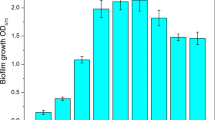Abstract
The effects of different nutrient sources and temperatures on attachment and biofilm formation of Pseudomonas fluorescens PSD4, a dairy isolate, were studied. Initial adherence and attachment capabilities among different strains were studied using microtitre plate assays. Biofilm development was observed using confocal microscopy. Strongly adherent cells were seen in protein rich media. Citrate as a carbon source enhanced biofilm formation. Glucose did not favor biofilm development. Psychrotrophic P. fluorescens PSD4 formed strongly adherent biofilms having high metabolic activities at low temperatures. P. fluorescens PSD4 with spoilage potential was capable of forming strong biofilms in dairy processing environments. Biofilm formation was influenced by nutrient availability and growth conditions. These factors should be considered for design of effective anti-biofilm strategies.
Similar content being viewed by others
References
Srey S, Jahid IK, Ha SD. Biofilm formation in food industries: A food safety concern. Food Control 31: 572–585 (2013)
Lewis K. Riddle of biofilm resistance. Antimicrob. Agents Ch. 45: 999–1007 (2001)
Costerton JW, Stewart PS, Greenberg EP. Bacterial biofilms: A common cause of persistent infections. Science 284: 1318–1322 (1999)
Simoes M, Simoes LC, Vieira MJ. A review of current and emergent biofilm control strategies. LWT-Food Sci. Technol. 43: 573–583 (2010)
Wiedmann MD, Weilmeier SS, Dineen R, Ralyea, Boor KJ. Molecular and phenotypic characterization of Pseudomonas spp. isolated from milk. Appl. Environ. Microb. 66: 2085–2095 (1999)
Dogan B, Boor KJ. Genetic diversity and spoilage potentials among Pseudomonas spp. isolated from fluid milk products and dairy processing plants. Appl. Environ. Microb. 69: 130–138 (2003)
Spilker T, Coenye T, Vandamme P, LiPuma JJ. PCR-based assay for differentiation of Pseudomonas aeruginosa from other Pseudomonas species recovered from cystic fibrosis patients. J. Clin. Microbiol. 42: 2074–2079 (2004)
Tamura K, Peterson D, Peterson N, Stecher G, Nei M, Kumar S. MEGA5: Molecular evolutionary genetics analysis using maximum likelihood, evolutionary distance, and maximum parsimony methods. Mol. Biol. Evol. 28: 2731–2739 (2011)
Hinsa MS, O’Toole GA. Biofilm formation by Pseudomonas fluorescens WCS365: A role for LapD. Microbiology 152: 1375–1383 (2006)
Van Houdt R, Aertsen A, Jansen A, Quintana AL, Michiels CW. Biofilm formation and cell-to-cell signalling in Gram-negative bacteria isolated from a food processing environment. J. Appl. Microbiol. 96: 177–184 (2004)
Sandasi M, Leonard C, Viljoen A. The in vitro antibiofilm activity of selected culinary herbs and medicinal plants against Listeria monocytogenes. Lett. Appl. Microbiol. 50: 30–35 (2010)
Cleto S, Matos S, Kluskens L, Vieira MJ. Characterization of contaminants from a sanitized milk processing plant. PLoS ONE 7: e40189 (2012)
Teh KH, Flint S, Palmer J, Lindsay D, Andrewes P, Bremer P. Thermo-resistant enzyme-producing bacteria isolated from the internal surfaces of raw milk tankers. Int. Dairy J. 21: 742–747 (2011)
Dourou D, Beauchamp CS, Yoon Y, Geornaras I, Belk KE, Smith G, Nychas G-JE, Sofos NJ. Attachment and biofilm formation by Escherichia coli O157:H7 at different temperatures, on different food-contact surfaces encountered in beef processing. Int. J. Food Microbiol. 149: 262–268 (2011)
Marchand S, Block JD, Jonghe VD, Coorevits A, Heyndrickx M, Herman L. Biofilm formation in milk production and processing environments; influence on milk quality and safety. Compr. Rev. Food Sci. F. 11: 133–147 (2012)
Teh KH, Flint S, palmer J, Andrews P, Bremer P, Lindsay D. Biofilm-An unrecognised source of spoilage enzymes in dairy products? Int. Dairy J. 34: 32–40 (2014)
Hood SK, Zottola EA. Adherence to stainless steel by food borne microorganisms during growth in model food systems. Int. J. Food Microbiol. 37: 145–153 (1997)
Hood SK, Zottola EA. Growth media and surface conditioning influence the adherence of Pseudomonas fragi, Salmonella typhimurium, and Listeria monocytogenes cells to stainless steel. J. Food Prot. 60: 1034–1037 (1997)
Kim H, Ryu J-H, Beuchat LR. Attachment of and biofilm formation by Enterobacter sakazakii on stainless steel and enteral feeding tubes. Appl. Environ. Microb. 72: 5846–5856 (2006)
Dancer GI, Mah JH, Kang DH. Influences of milk components on biofilm formation of Cronobacter spp. (Enterobacter sakazakii). Lett. Appl. Microbiol. 48: 718–725 (2009)
Varhimo E, Varmanen P, Fallarero A, Skogman M, Pyorala S, Iivanainen A, Sukura A, Vuorela, Savijoki. Alpha- and β-casein components of host milk induce biofilm formation in the mastitis bacterium Streptococcus uberis. Vet. Microbiol. 149: 381–389 (2011)
Caiazza NC, O’Toole GA. SadB is required for the transition from reversible to irreversible attachment during bioWlm formation by Pseudomonas aeruginosa PA14. J. Bacteriol. 186: 4476–4485 (2004)
O’Toole GA, Kolter R. Initiation of biofilm formation in Pseudomonas fluorescens WCS365 proceeds via multiple, convergent signaling pathways: A genetic analysis. Mol. Microbiol. 28: 449–461 (1998)
Hinsa SM, Espinosa-Urgel M, Ramos JL, O’toole GA. Transition from reversible to irreversible attachment during biofilm formation by Pseudomonas fluorescens WCS365 requires an ABC transporter and a large secreted protein. Mol. Microbiol. 49: 905–918 (2003)
Klausen M, Heydorn A, Ragas P, Lambertsen L, Aaes-Jorgensen A, Molin S, Tolker-Nielsen T. Biofilm formation by Pseudomonas aeruginosa wild type, flagella, and type IV pili mutants. Mol. Microbiol. 48: 1511–1524 (2003)
Klausen M, Gjeremansen M, Kreft JU, Tolker-Nielsen T. Dynamics of development and dispersal in sessile microbial communities: Examples from Pseudomonas aeruginosa and Pseudomonas putida model biofilms. FEMS Microbiol. Lett. 261: 1–11 (2000)
Heydorn A, Nielsen AT, Hentzer M, Sternberg C, Givskov M, Ersboll BK, Molin S. Quantification of biofilm structures by the novel computer program COMSTAT. Microbiology 146: 2395–2407 (2000)
Author information
Authors and Affiliations
Corresponding author
Rights and permissions
About this article
Cite this article
Aswathanarayan, J.B., Vittal, R.R. Attachment and biofilm formation of Pseudomonas fluorescens PSD4 isolated from a dairy processing line. Food Sci Biotechnol 23, 1903–1910 (2014). https://doi.org/10.1007/s10068-014-0260-8
Received:
Revised:
Accepted:
Published:
Issue Date:
DOI: https://doi.org/10.1007/s10068-014-0260-8




